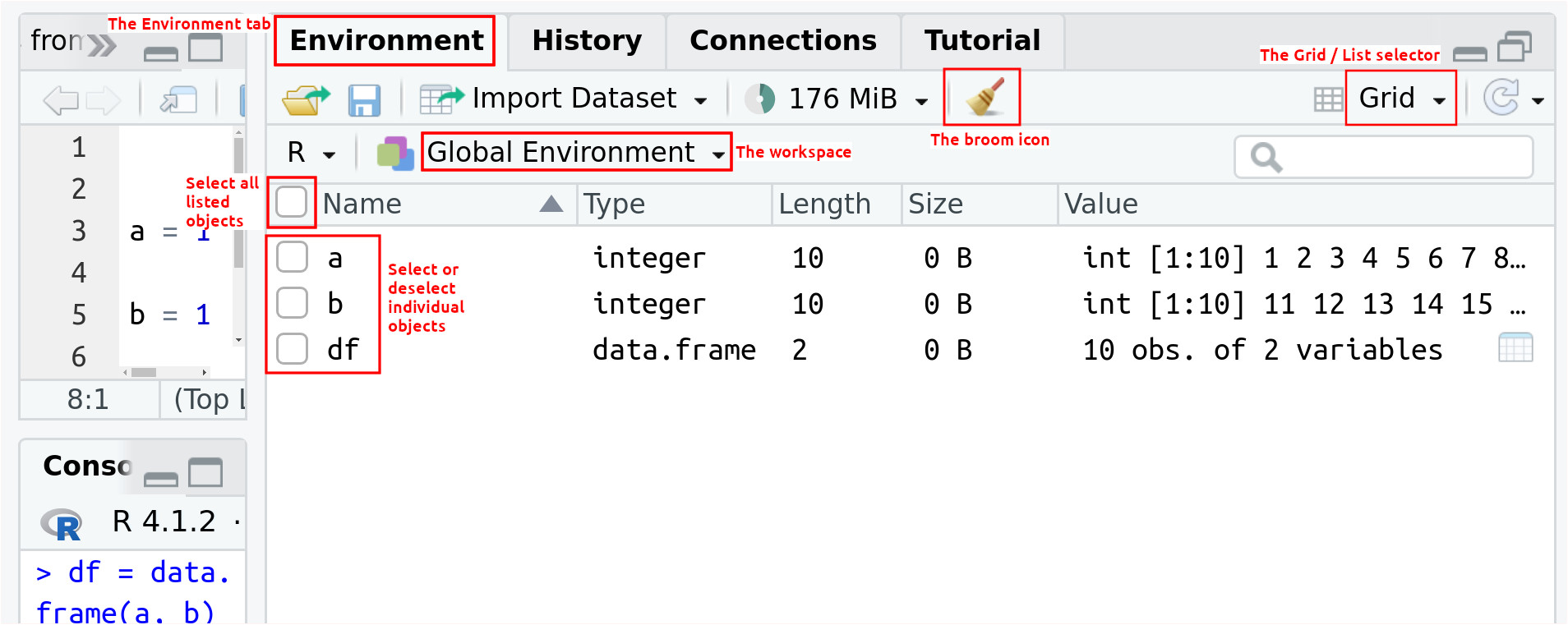从 R 中的工作区中删除用户定义的对象
我们的数据分析可能会创建许多占用内存的对象。本文介绍如何使用 rm() 函数和 R Studio 的 Environment 选项卡从 R 中的工作区中删除用户定义的对象。
使用 rm() 函数从 R 中的工作区中删除用户定义的对象
在我们的 R 脚本中,我们可以使用 rm() 或 remove() 函数来删除对象。这两个功能是相同的。
我们可以将要删除的对象指定为变量、字符串或提供给 list 参数的字符向量。
示例代码:
# Make several objects.
a = 1:10
b = 11:20
c = c(a,b)
df1 = data.frame(a, b)
x = a
y = b
z = c
df2 = data.frame(x, y)
df3 = cbind(df1, df2)
# Lists the objects in the top level (global) environment.
ls()
# Remove one object.
# Specify as a variable.
rm(a)
# Check the list.
ls()
# Remove another object.
# Specify as a string.
rm("b")
# Check the list.
ls()
# Remove multiple objects as variables.
rm(x, y)
# Check the list.
ls()
# Remove multiple objects as strings.
rm("df1", "df2")
# Check the list.
ls()
# Remove multiple objects by providing a character vector to list.
rm(list = c("c", "z"))
# Check the list.
ls()
输出:
> # Lists the objects in the top level (global) environment.
> ls()
[1] "a" "b" "c" "df1" "df2" "df3" "x" "y" "z"
>
> # Remove one object.
> # Specify as a variable.
> rm(a)
> # Check the list.
> ls()
[1] "b" "c" "df1" "df2" "df3" "x" "y" "z"
>
> # Remove another object.
> # Specify as a string.
> rm("b")
> # Check the list.
> ls()
[1] "c" "df1" "df2" "df3" "x" "y" "z"
>
> # Remove multiple objects as variables.
> rm(x, y)
> # Check the list.
> ls()
[1] "c" "df1" "df2" "df3" "z"
>
> # Remove multiple objects as strings.
> rm("df1", "df2")
> # Check the list.
> ls()
[1] "c" "df3" "z"
>
> # Remove multiple objects by providing a character vector to list.
> rm(list = c("c", "z"))
> # Check the list.
> ls()
[1] "df3"
我们可以通过将 ls() 函数的输出提供给 rm() 函数的 list 参数来一次删除所有用户定义的对象。
该文档指定该操作将在没有警告的情况下执行,并建议用户除非确定,否则不应使用它。
示例代码:
# Again create some objects.
A = 100:110
B = 200:210
DF1 = data.frame(A, B)
# Check the list of objects.
ls()
# Remove all user-defined objects.
rm(list = ls())
# Check the list of objects.
ls()
输出:
> # Check the list of objects.
> ls()
[1] "A" "B" "DF1" "df3"
>
> # Remove all user-defined objects.
> rm(list = ls())
> # Check the list of objects.
> ls()
character(0)
使用 R Studio 界面从 R 中的工作区中删除用户定义的对象
R Studio 可以非常方便地从内存中删除用户定义的对象。
R Studio 界面的右上角面板有一个环境选项卡,其中列出了所有用户定义的对象。
在第一行图标中,请注意中间的扫帚图标和远端的网格或列表下拉选择器,就在刷新按钮之前。我们需要选择 Grid 来控制我们从工作区中删除哪些对象。
在第二行图标中,请注意标签 Global Environment。
当我们在第一行图标中选择 Grid 时,我们会得到列名。注意所有列名前面的选择框和列表中每个对象的选择框。

我们可以通过单击扫帚图标来移除对象。可用的不同选项如下。
-
未选择任何对象时单击扫帚图标将删除所有用户定义的对象,包括隐藏对象(选择器出现在确认对话框中)。
-
选择一个或多个对象并单击扫帚图标将删除所选对象。
-
通过单击列名称列表中的选择器选择所有对象,然后单击扫帚图标将删除列表中所有可见(和选择)的对象。
-
要保留一个或多个对象并删除所有其他对象,我们可以手动取消选择这些对象,或者我们可以执行以下操作:
-
单击列名行中的选择器以选择所有对象。
-
取消选择我们要保留的对象。
-
点击扫帚图标。只有未选择的对象将保留。
结论
我们可以使用 rm() 函数从工作区中删除用户定义的对象。R Studio 的环境选项卡使这项任务变得更容易。
相关文章
R 中具有多个条件的函数向量化
发布时间:2023/03/21 浏览次数:72 分类:编程语言
-
一项常见的数据分析任务是根据同一行的其他列使用一个或多个条件创建或更新数据框列。 如果我们尝试使用 if 语句来执行此操作,则只会使用第一行来测试条件,并且会根据该行更
在 R 中读取 xlsx 文件
发布时间:2023/03/21 浏览次数:198 分类:编程语言
-
在这篇文章中,你将会了解到两个在 R 中读取 xlsx 文件的最完整和最容易使用的库:readxl 和 openxlsx。

